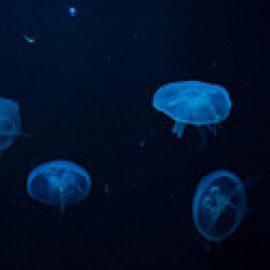Bio-Regional Thinking and the Deep Sea
-
English
-
ListenPause
[intro music]
Welcome to World Ocean Radio…
I’m Peter Neill, Director of the World Ocean Observatory.
A key element in how to plan for sustainability action is found in the emergence of the concept of the bio-region, an area not defined by political boundaries but by ecological systems. When we talk about watersheds, for example, we are describing the entirety of what lives there: plants, animals, people, all interacting in a complex reaction to natural and social activities from within, and from without, that must be included in a comprehensive understanding of operation, adaptation, and societal response for such a system to endure and flourish.
Scientists organize bio-regions by analyzing 14 major biome types – deserts, mountains, grasslands, forests, tundra, etc – and have mapped some 185 such areas, and then further organized these into “realms,” broad divisions of the Earth’s surface, such as Sub-Arctic America, North America, Western Eurasia, Afrotropics, Indomalaya, Australasia, Oceana, and Antarctica among others. Descending deeper, further distinctions are created – between terrestrial, freshwater, and marine – and then all this observation coordinated and mapped, as a profile of the natural world around us available for planning strategies for environmental protection, community development, sustainable practice, a viable interaction between man and Nature that shapes and enables our future.
But there are other perspectives that can be brought to bear: investment bio-regions, for example, another superimposition of financial data and analysis that relates natural capital to human capital to market capital. We have spoken often on World Ocean Radio of “externalities,” costs and consequences that are not included in our present-day plans, permits, and estimates of true cost and negative consequence. Bio-regional thinking applied to development raises and demands mitigation of consequence in advance, integrating human influence and social patterns and moderating conflict and relieving foreseeable problems before they happen.
[The philosopher Peter Berg takes an even higher view, called “bio-culturalism,” which unites the needs of every element in the system, expressed as relationships, religion, art, food, water, and environmental conservation and management into an even more-inclusive eco-oriented future-building machine.]
When I look at the bio-regional maps, I notice that they only extend from the land into the sea to the extent of each nation’s “exclusive economic zone,” paradoxically a boundary of the kind transcended on landside projections. What becomes clear is that almost 70% of the surface of the planet is ocean and is not included, or at least left out of the bioregional vision. Marine protected areas are the maritime answer to this irony: vast areas of ocean designated and protected from destructive behaviors, but, as they are sponsored and validated by national governments, they remain still inside the terrestrial field of interest and control. Such areas are great examples of bio-regional practice, but, according to the Pew Trust and the UN World Data Base for Marine Protected Areas, while there are some 15,000 MPAs worldwide protecting more than 10 million square miles of ocean, that represents only 7.5 % of the ocean area, leaving the entirety of the rest, 82.5 % of the most vital bio-region on earth unaddressed and vulnerable.
Let’s think for a minute about that ocean, beginning at its outermost limit, the surface of the sea, and let’s imagine the water column descending down through thousands of species in their dynamic habitat, down to the floor, an average depth of more than 12,000 feet, to a place without light where, still, creatures live in a biotic complexity, so different and yet so similar to the land. In each marine bioregion, located in all those “realms,” there is comparable life, no, in truth, incomparable life in that what is found there survives in an entirely different biome called ‘the abyssal plain.” The plants and animals and conditions there are unlike anywhere else on earth; it is a world so old, and, because we are now suddenly aware, so new to our science and our understanding. We become aware of creatures never seen before, of microscopic entities that behave like no other, of knowledge not yet released into the academic journals, aquaria, and public awareness. Images of observation there are breath-taking, bizarre, unique, alive in the dark without oxygen. It is the most beautiful bio-region of them all, primarily as we have not yet despoiled it. Everything we are doing on land, whether or not informed by a bio-regional or sustainability perspective, is now a reaction to what we have done there historically. Not so in the deep sea. It has no history that we yet understand. Let’s call this region “mystery.” Is it possible we can just imagine it’s there, be grateful and leave this ocean place alone?
We will discuss these issues, and more, in future editions of World Ocean Radio.
[Outro music]
Bio-regions on Earth are organized into types, then realms, and are further distinguished and mapped for planning, strategizing, developing, and as a tool for protection of the planet. A major trouble with bio-regional mapping is that it neglects nearly 83 percent of the ocean–beyond marine protected areas–leaving the high seas and deep sea unaddressed and vulnerable.
About World Ocean Radio
World Ocean Radio is a weekly series of five-minute audio essays available for syndicated use at no cost by college and community radio stations worldwide. Peter Neill, Director of the World Ocean Observatory and host of World Ocean Radio, provides coverage of a broad spectrum of ocean issues from science and education to advocacy and exemplary projects.
World Ocean Radio
14 Years, 700+ Episodes
Ocean is climate
Climate is ocean
The sea connects all things
- Login to post comments



